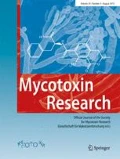Abstract
A biopesticide, afla-guard®, has been developed for controlling aflatoxin contamination in peanuts. This product provides the means of introducing a competitive, non-aflatoxigenic strain ofAspergillus flavus into soils where peanuts are being grown. The introduced strain competitively excludes toxigenic strains naturally present from invading developing peanuts. The biocontrol technology was made commercially available in 2004 by Circle One Global, Inc., upon receiving U.S. Environmental Protection Agency section 3 registration of afla-guard® as a biopesticide. The product was applied to approximately 2000 ha of peanuts in Georgia and Alabama during the 2004 crop year. Application of afla-guard® changed the composition ofA. flavus soil populations from an average 71.1% toxigenic strains in untreated fields to only 4.0% in treated soils. Analyses of farmer's stock peanuts being delivered at seven different locations showed a consistent reduction in aflatoxin contamination in peanuts from fields treated with afla-guard®. Over all locations, aflatoxin averaged 78.9 ng/g in untreated peanuts compared with 11.7 ng/g in treated peanuts, an 85.2% reduction. Peanuts from treated and untreated fields were stored together in separate warehouse bins at two different locations. Aflatoxin analyses at the Unadilla, GA location showed that 48.4% of shelled edible lots from untreated fields contained unacceptable levels of aflatoxin (>15 ng/g). At the Dawson, GA location, 15.8% of shelled lots from untreated fields contained >15 ng/g. At both locations, no shelled edible lots from treated fields contained >15 ng/g. Mean aflatoxin concentrations in edible peanuts from untreated and treated fields at Unadilla were 36.2 and 0.9 ng/g, respectively. At Dawson the respective means were 7.2 and 2.2 ng/g.
Similar content being viewed by others
References
Cole RJ, Sanders TH, Dorner JW, Blankenship PD (1989) Environmental conditions required to induce preharvest aflatoxin contamination of groundnuts: summary of six years' research. In: Hall SD (ed) Aflatoxin Contamination of Groundnut: Proceedings of the International Workshop, 6–9 Oct 1987, ICRISAT Center, Patancheru, A.P. 502 324, India, 279–287
Lancaster MC, Jenkins GP, Philp JM (1961) Toxicity associated with certain samples of groundnuts. Nature 192: 1095–1096
Sargeant K, Sheridan A, O'Kelly J, Carnaghan RBA (1961) Toxicity associated with certain samples of groundnuts. Nature 192: 1096–1097
Code of Federal Regulations (2005) Minimum quality and handling standards for domestic and imported peanuts marketed in the United States CFR 996: 736–746
Cole RJ, Dorner JW, Holbrook CC (1995) Advances in mycotoxin elimination and resistance. In: Stalker HT, Pattee HE (ed) Advances in Peanut Science. American Peanut Research and Education Society, Stillwater, OK, 456–474
Dorner JW (2004) Biological control of aflatoxin contamination of crops. J Toxicol-Toxin Rev 23: 425–450
Dorner JW, Cole RJ, Blankenship PD (1992) Use of a biocompetitive agent to control preharvest aflatoxin in drought stressed peanuts. J Food Prot 55: 888–892
Dorner JW, Cole RJ, Blankenship PD (1998) Effect of inoculum rate of biological control agents on preharvest aflatoxin contamination of peanuts. Biol Control 12: 171–176
Dorner JW, Cole RJ (2002) Effect of application of nontoxigenic strains ofAspergillus flavus andA. parasiticus on subsequent aflatoxin contamination of peanuts in storage. J Stored Prod Res 38: 329–339
Dorner JW (2004) Combined effects of biological control formulations, cultivars, and fungicides on preharvest colonization and aflatoxin contamination of peanuts byAspergillus spp. Peanut Sci. 31: 79–86
Brown RL, Cotty PJ, Cleveland TE (1991) Reduction in aflatoxin content of maize by atoxigenic strains ofAspergillus flavus. J Food Prot 54: 623–626
Dorner JW, Cole RJ, Wicklow DT (1999) Aflatoxin reduction in corn through field application of competitive fungi. J Food Prot 62: 650–656
Cotty PJ (1994) Influence of field application of an atogenic strain ofAspergillus flavus on the populations ofA. flavus infecting cotton bolls and on the aflatoxin content of cottonseed. Phytopathology 84: 1270–1277
Cole RJ, Dorner JW (2001) Biological control formulations containing spores of nontoxigenic strains of fungi for toxin control of food crops. US Patent No. 6,306,386
www.epa.gov/oppbppd1/biopesticides/ ingredients/tech/docs/brad. 006500.pdf
Horn BW, Dorner JW (1998) Soil populations ofAspergillus species from sectionFlavi along a transect through peanut-growing regions of the United States. Mycologia 90: 767–776
Horn BW, Greene RL, Sobolev VS, Dorner JW, Powell JH, Layton RC (1996) Association of morphology and mycotoxin production with vegetative compatibility groups inAspergillus flavus, A. parasiticus, andA. tamarii. Mycologia 88: 574–587
Davidson JI, Whitaker TB, Dickens JW (1982) Grading, cleaning, storage, shelling, and marketing of peanuts in the United States. In: Pattee HE, Young CT (ed) Peanut Science and Technology. American Peanut Research and Education Society, Yoakum, TX, 571–623
Dorner JW (2002) Simultaneous quantitation ofAspergillus flavus/A. parasiticus and aflatoxin in peanuts. J AOAC Int. 85: 911–916
Sobolev VS, Dorner JW (2002) Cleanup procedure for determination of aflatoxins in major agricultural commodities by liquid chromatography. J AOAC Int 85: 42–645
Lamb MC, Cole RJ, Henning RJ, Dorner JW, Davidson JI (1993) Economic feasibility of recovering edible peanuts from aflatoxin contaminated lots. Proc Am Peanut Res Educ Soc 25: 82
Author information
Authors and Affiliations
Corresponding author
Rights and permissions
About this article
Cite this article
Dorner, J.W., Lamb, M.C. Development and commercial use of afla-Guard®, an aflatoxin biocontrol agent. Mycotox Res 22, 33–38 (2006). https://doi.org/10.1007/BF02954555
Issue Date:
DOI: https://doi.org/10.1007/BF02954555




